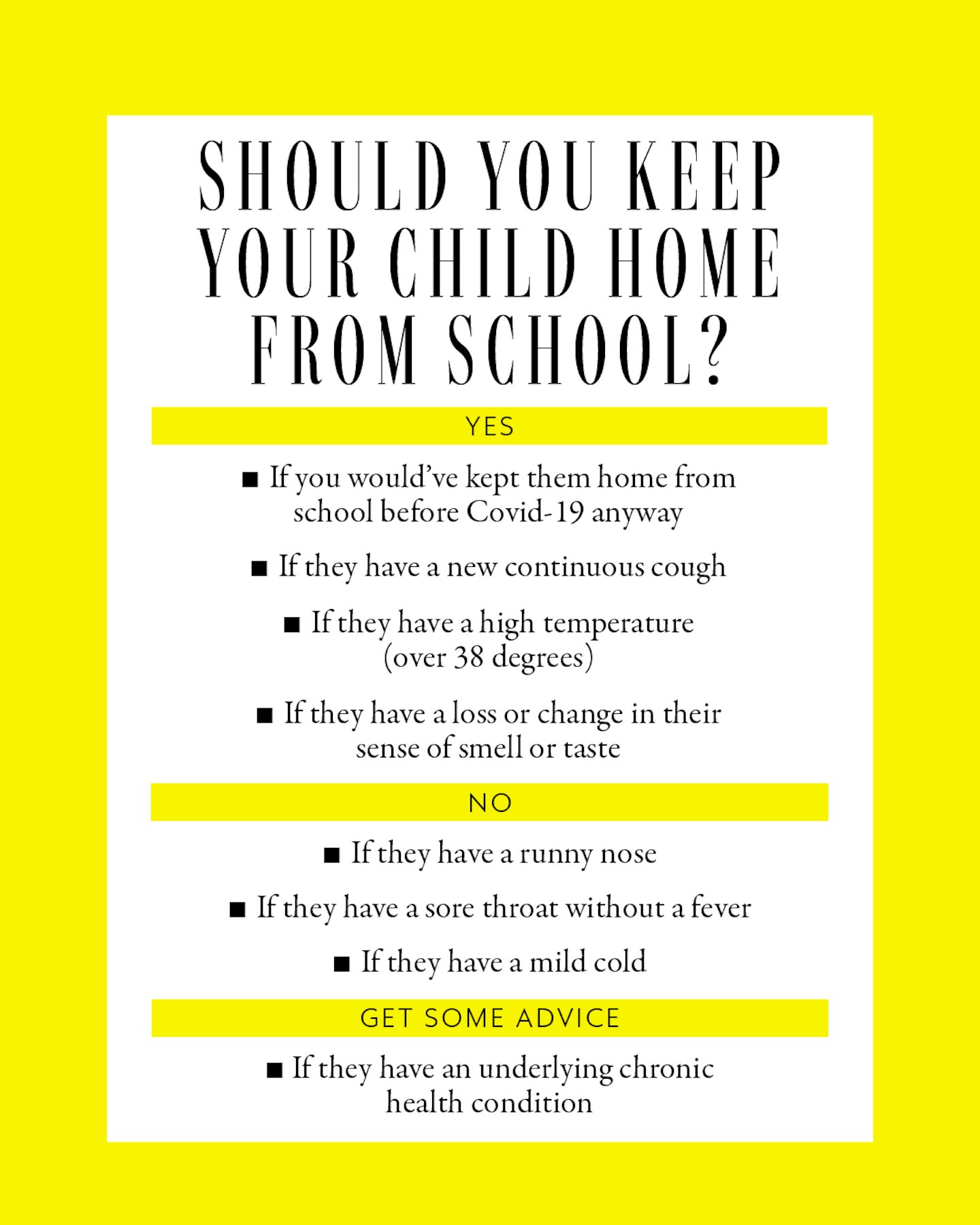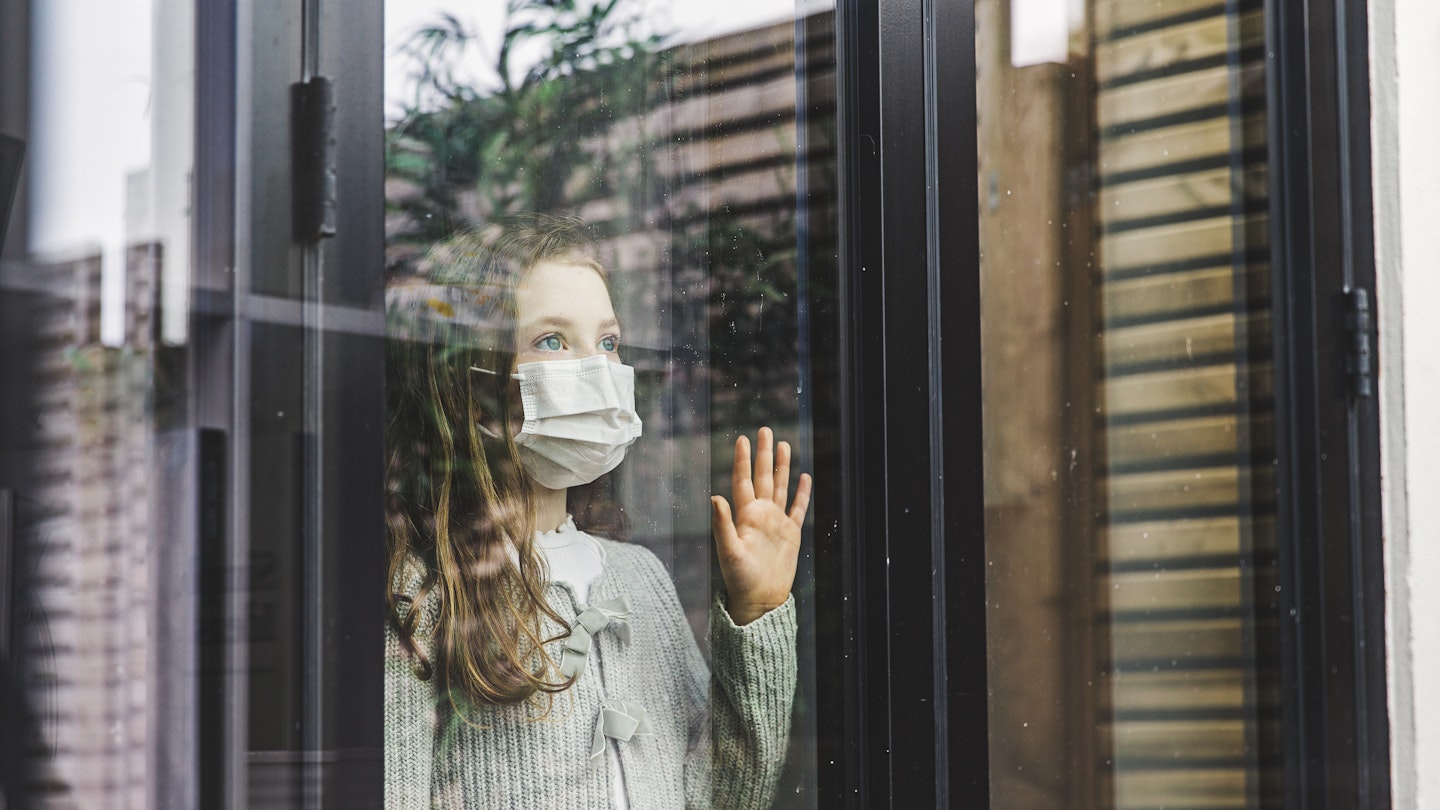‘My son was sent home from school because of a “persistent cough”. He actually has a sore throat and a slight cough. I’ve spent hours on the phone and online but I can’t get a test anywhere in London, not even one by post. He now has to stay at home for 10 days, after missing months of school.’
Jenny, mother of two, is one of many mothers in crisis over their children’s schooling right now. As we enter cold and flu season amid a global pandemic with symptoms that can be eerily similar to less sinister illnesses, keeping kids in school after so much time off is a priority. But so is keeping everyone safe.
It’s causing mass confusion, anxiety and anger, with questions coming out of parents ears. ‘I sent my child to school with a runny nose this morning,’ Charlotte, mother of two, told Grazia. ‘Then I panicked all day about whether I should or I shouldn’t. It’s not a Covid-19 symptom, but kids are being sent home for less.’
That was the case for Jenny, who's now left needing full-time childcare and wondering what she could’ve done differently to keep her child in school should it turn out he not have coronavirus. ‘I just want to know, are schools really going to send every child home who has a cough?’ she questioned. ‘I’m wondering if the best strategy would be to keep them off school if they have a cold, to avoid them being suspected of having Covid?’
With so much confusion, and so little clarify from the government, we reached out to Dr Liz Whittaker, senior clinical lecturer in paediatric infectious diseases and immunology at imperial College London. Here, she answers all your kid-related Covid-19 questions.
How is Covid-19 different in children compared to adults?
Reassuringly, children experience much milder disease with Covid-19 than adults. Of 300,000 positive tests from March to August 2020, only 9000 were in children. In the largest dataset of hospitalised children with Covid-19 (651 admitted from March-July 2020), there were 116 admissions to critical care and 6 deaths. This included 52 children with the inflammatory syndrome PIMS-TS, all of whom made a full recovery within a few days. In many population surveys children testing positive are under-represented compared to adults (4% vs 19-32%).
When should I be testing my child for Covid-19?
We know that 30-50% of children with Covid-19 are asymptomatic. This means that unless we test all children weekly we will be unable to identify cases of in children. This is neither feasible, nor acceptable to children, never mind their parents! Therefore, we need to do symptomatic testing and consider why we are testing.
Reassuringly, children with Covid are rarely very unwell. Therefore, the aim of testing and isolation is to identify the majority of children with Covid, to identify outbreaks or clusters and then to limit the further spread of these outbreaks -this may be through isolation of ‘bubbles’ in school, or if there is a lot of community transmission, for a local lockdown. There is a balance between the benefit of testing and isolating children for these reasons and the downside of children unnecessarily missing school and staying at home.
Are Covid-19 symptoms different in children?
Children who are symptomatic with Covid present with fever (40-50%), cough (40-50%), but also other symptoms like headache (13%), fatigue and myalgia (10-12%), snotty nose (16%), sore throat (14%) and diarrhoea (10%). However, these less common symptoms are seen in a variety of other childhood illnesses that are common at this time of the year. The majority of children who present with these ‘upper respiratory infections’ (URI) do not have Covid – one study (Ladhani et al) showed 2.8% of children tested with URI during the pandemic were positive for Covid-19, (and only 4% of 35,000 children tested) and recently, only 0.03% of 17,000 Scottish school children tested in the first few weeks of school were positive.
My child has cold symptoms, should I take them for a test?
A snotty child who is tested for Coronavirus has a 97.2-99.97% chance of having a negative test. By just testing and isolating those children with the most common symptoms (fever and continuous cough - most likely to be dry and an early symptom, rather than throat clearing phlegmy with snot), we are likely to identify outbreaks and can limit the number of children missing school unnecessarily. If all children with less common symptoms are tested, the testing system will not function to identify those children who have got Covid.
Should I be sending my child to school with a runny nose, sore throat or mild cold?

Should primary school age children wear masks?
The benefit of a child under the age of 11 wearing a mask is limited in the school setting. Remember, a mask primarily protects other people from you, rather than offering complete protection. Children under the age of 11 are very unlikely to experience symptomatic COVID disease – many are asymptomatic. While children have plenty of the virus around in their secretions when infected, as they are coughing less, it is likely they transmit less. Many studies have shown that children of this age are more likely to get infected by an adult, than to pass it on to them.
For this reason, transmission in primary schools is likely to be driven by the adults associated with the school – so it is really important that the adults are behaving well – socially distancing, limiting their risk in the community (masks in crowded areas) and hand hygiene. Encouraging hand hygiene in children is also likely to limit spread. Masks may inhibit learning potential, and are unlikely to be worn effectively in young children.
However, we should not punish or ridicule anyone who chooses to wear a mask, or cannot wear a mask for whatever reason, this is an ideal opportunity to teach our children tolerance and understanding that everyone is different, and these differences may not always be visible.
Read More:
Coronavirus: What Is PIMS-TS, The Kawasaki-Like Disease Impacting Children?
Coronavirus Lockdown Is Widening The Kids Versus No Kids Divide
What Has The Psychological Impact Of Lockdown Been On Nursery-Age Children?
